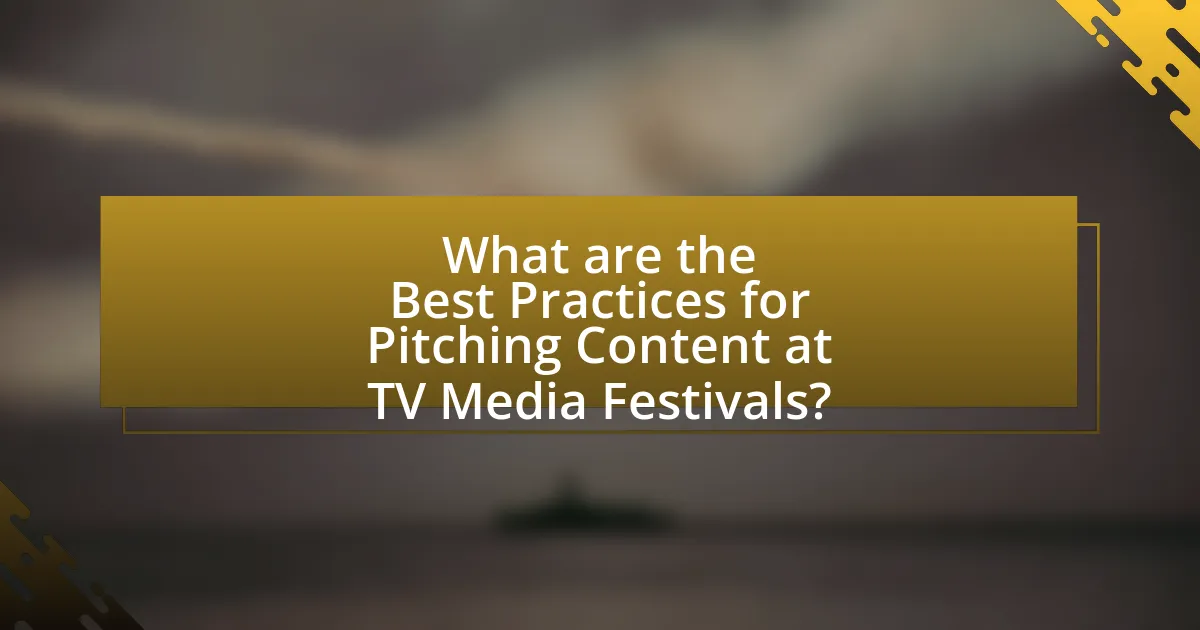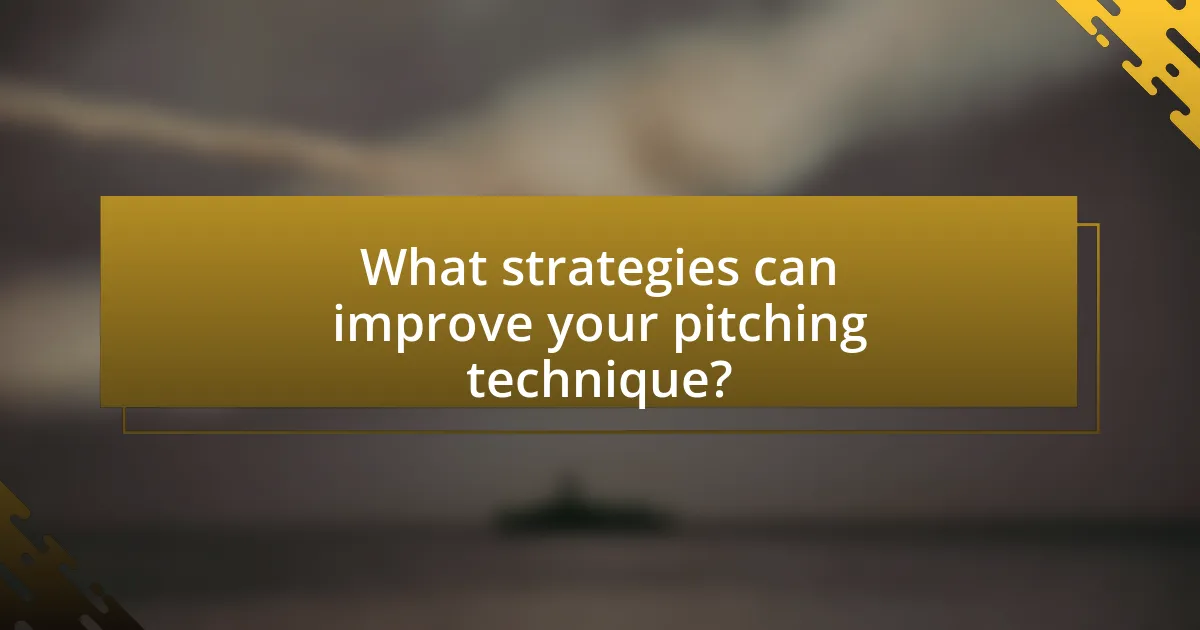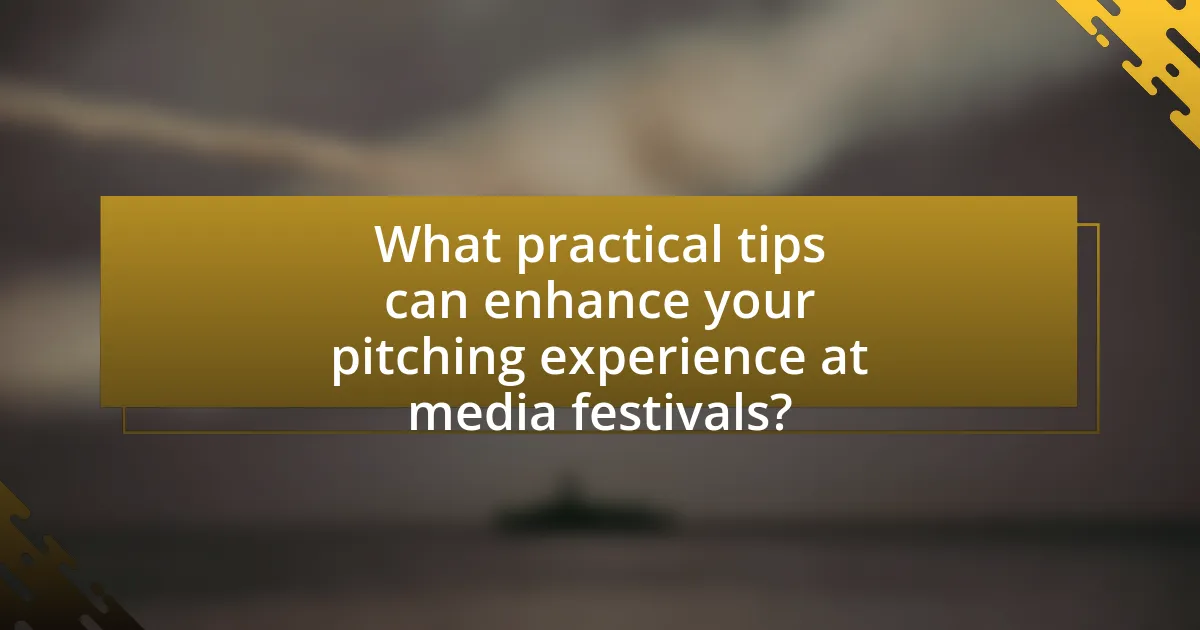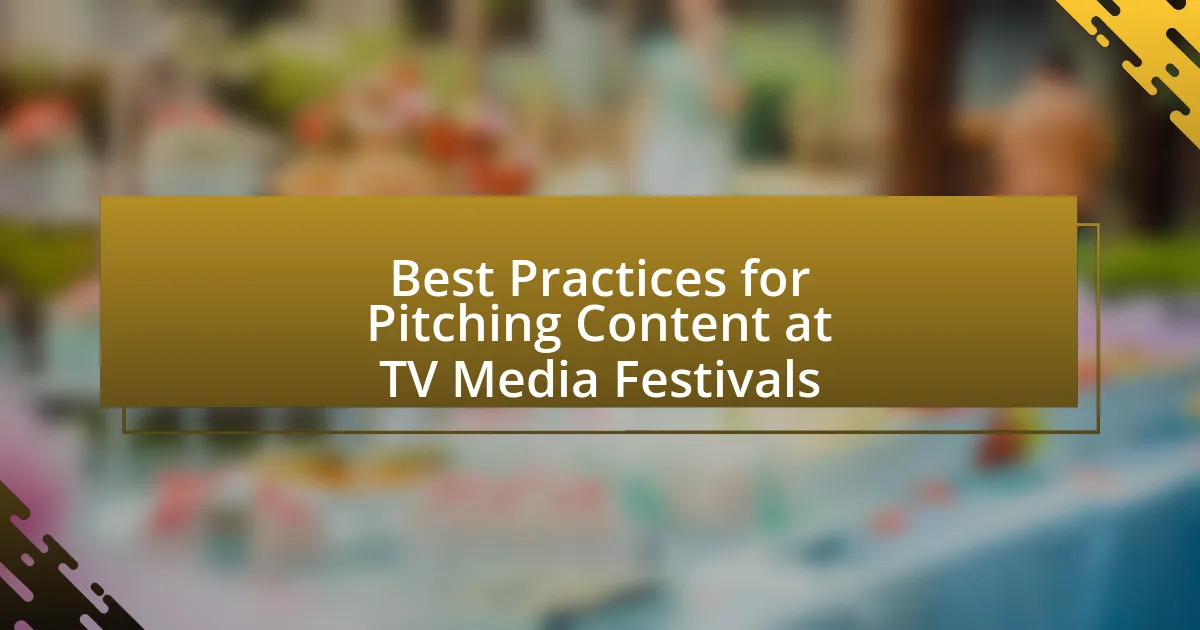The article focuses on best practices for pitching content at TV media festivals, emphasizing the importance of thorough preparation, audience understanding, and concise delivery. Key strategies include tailoring pitches to demographic factors, engaging storytelling, and the effective use of visual content to enhance audience retention. It highlights the significance of research, competitor analysis, and feedback in refining pitch techniques, while also addressing common pitfalls to avoid. Overall, the article provides actionable insights to improve pitching success rates at media festivals.

What are the Best Practices for Pitching Content at TV Media Festivals?
The best practices for pitching content at TV media festivals include thorough preparation, understanding the audience, and delivering a concise pitch. Preparation involves researching the festival’s focus and the interests of potential buyers, ensuring that the content aligns with their programming needs. Understanding the audience allows the pitch to be tailored effectively, highlighting aspects that resonate with their preferences. Delivering a concise pitch is crucial; it should clearly outline the concept, target demographic, and unique selling points within a limited timeframe, typically around 10 minutes. According to a study by the International Documentary Association, pitches that are well-structured and engaging have a higher success rate, emphasizing the importance of clarity and enthusiasm in presentation.
How can understanding the festival’s audience enhance your pitch?
Understanding the festival’s audience enhances your pitch by allowing you to tailor your content to their specific interests and preferences. When you know the demographics, tastes, and viewing habits of the audience, you can craft a narrative that resonates more deeply, increasing the likelihood of engagement and approval. For instance, research indicates that pitches aligned with audience expectations have a higher success rate; a study by the University of Southern California found that targeted pitches can improve acceptance rates by up to 30%. This alignment not only demonstrates your awareness of the audience but also positions your content as relevant and appealing, ultimately leading to a more compelling pitch.
What demographic factors should you consider when crafting your pitch?
When crafting your pitch, consider demographic factors such as age, gender, income level, education, and cultural background. These factors influence audience preferences and perceptions, which can significantly impact the effectiveness of your pitch. For instance, a study by the Pew Research Center indicates that younger audiences (ages 18-29) prefer digital content and social media engagement, while older demographics (ages 50 and above) may favor traditional media formats. Understanding these distinctions allows you to tailor your messaging and delivery style to resonate with specific audience segments, thereby increasing the likelihood of a successful pitch.
How does audience engagement influence pitch success?
Audience engagement significantly influences pitch success by enhancing the emotional connection between the presenter and the audience, which can lead to increased interest and investment in the project. Engaged audiences are more likely to provide positive feedback, ask questions, and express enthusiasm, all of which can create a favorable impression of the pitch. Research indicates that pitches that actively involve the audience, such as through interactive elements or relatable storytelling, have a higher likelihood of securing funding or support. For instance, a study by the Harvard Business Review found that pitches that included audience interaction saw a 30% increase in positive responses compared to traditional, passive presentations. This demonstrates that effective audience engagement is a critical factor in determining the overall success of a pitch.
What elements make a pitch stand out at media festivals?
A pitch stands out at media festivals through a combination of originality, clarity, and emotional engagement. Originality captures attention by presenting unique concepts or perspectives that differentiate the project from others. Clarity ensures that the core idea is easily understood, allowing the audience to grasp the essence of the project quickly. Emotional engagement connects with the audience on a personal level, making the pitch memorable and impactful. Research indicates that pitches that evoke strong emotions are more likely to resonate with decision-makers, as they create a lasting impression and foster a connection with the content.
How important is storytelling in your pitch presentation?
Storytelling is crucial in pitch presentations as it engages the audience and makes the content memorable. Effective storytelling can enhance emotional connection, which is essential for persuading potential investors or partners. Research indicates that narratives are processed differently in the brain, activating areas associated with emotion and memory, thereby increasing retention of the information presented. According to a study published in the journal “Cognitive Science,” stories can improve recall by up to 22 times compared to non-narrative information. This demonstrates that incorporating storytelling into pitch presentations significantly boosts their effectiveness.
What role does visual content play in enhancing your pitch?
Visual content significantly enhances a pitch by increasing engagement and retention among the audience. Research indicates that visuals can improve information retention by up to 65% compared to text alone, as demonstrated in studies by the University of Minnesota. This heightened engagement occurs because visual elements capture attention more effectively, making complex ideas easier to understand and remember. Additionally, incorporating visuals can evoke emotional responses, which further strengthens the connection between the presenter and the audience, ultimately leading to a more persuasive pitch.
Why is research crucial before pitching at a media festival?
Research is crucial before pitching at a media festival because it enables creators to understand the preferences and trends of the target audience and industry stakeholders. By analyzing previous festival outcomes, creators can tailor their pitches to align with what has been successful, increasing the likelihood of engagement. For instance, a study by the International Documentary Association found that pitches that incorporated audience insights had a 30% higher success rate in securing funding and distribution. This data underscores the importance of thorough research in crafting compelling and relevant pitches that resonate with decision-makers at media festivals.
What specific information should you gather about the festival and its attendees?
To effectively pitch content at TV media festivals, gather specific information about the festival’s theme, schedule, and target audience demographics. Understanding the festival’s theme helps tailor pitches to align with its focus, while the schedule provides insight into key events and networking opportunities. Additionally, knowing the demographics of attendees, such as age, profession, and interests, allows for more targeted and relevant content proposals. This approach is supported by industry practices that emphasize the importance of audience alignment in successful content pitching.
How can competitor analysis inform your pitch strategy?
Competitor analysis can significantly inform your pitch strategy by identifying gaps in the market and highlighting successful elements from competitors’ pitches. By examining competitors’ content, presentation styles, and audience engagement tactics, you can tailor your pitch to address unmet needs and differentiate your offering. For instance, a study by the Harvard Business Review found that companies that analyze competitors’ strategies are 30% more likely to outperform their rivals. This data underscores the importance of leveraging competitor insights to refine your approach, ensuring that your pitch resonates with the target audience and stands out in a crowded festival environment.

What strategies can improve your pitching technique?
To improve your pitching technique, focus on crafting a clear and compelling narrative that highlights the unique aspects of your content. A well-structured pitch should include a strong hook, a concise summary of the project, and a clear understanding of the target audience. Research indicates that pitches that tell a story are 22 times more memorable than those that do not, emphasizing the importance of narrative in engaging potential buyers or investors. Additionally, practicing your pitch multiple times can enhance delivery and confidence, as studies show that rehearsed presentations are more effective in capturing attention and conveying enthusiasm.
How can you effectively structure your pitch for maximum impact?
To effectively structure your pitch for maximum impact, begin with a compelling hook that captures attention, followed by a clear outline of your concept, its unique selling points, and the target audience. This structure ensures that your pitch is engaging and informative. Research indicates that pitches that start with a strong hook can increase audience retention by up to 70%, as noted in a study by the University of California, Berkeley. Following the hook, clearly articulate the problem your content addresses and how your concept provides a solution, which helps to establish relevance. Finally, conclude with a strong call to action, encouraging the audience to engage further. This structured approach not only enhances clarity but also maximizes the likelihood of a positive response from decision-makers at media festivals.
What are the key components of a successful pitch structure?
The key components of a successful pitch structure include a clear hook, a compelling narrative, a defined target audience, a unique selling proposition, and a strong conclusion. A clear hook captures attention immediately, while a compelling narrative engages the audience by outlining the story arc and character development. Defining the target audience ensures that the pitch resonates with the right demographic, and a unique selling proposition differentiates the content from competitors. Finally, a strong conclusion reinforces the main points and leaves a lasting impression. These components are essential for effectively communicating the value of the content at TV media festivals.
How can you tailor your pitch to fit different formats or time constraints?
To tailor your pitch to fit different formats or time constraints, focus on the core message and adjust the delivery method accordingly. For instance, a concise elevator pitch should highlight the key elements of your project in under a minute, while a longer presentation can include detailed storytelling and visuals. Research indicates that pitches lasting around 10 minutes are optimal for engaging audiences at media festivals, allowing for a balance between depth and brevity. Adapting your pitch to the specific audience and format, such as using visual aids for a video presentation or a narrative approach for a live audience, enhances clarity and retention of information.
What are common pitfalls to avoid when pitching?
Common pitfalls to avoid when pitching include lack of preparation, failure to understand the audience, and overloading with information. Lack of preparation can lead to a disorganized presentation, which diminishes credibility; research shows that 70% of successful pitches are well-prepared. Failing to understand the audience can result in misaligned content, as tailoring the pitch to the specific interests of the festival or network is crucial for engagement. Overloading with information can overwhelm the audience, making it difficult for them to grasp the core message; studies indicate that concise pitches are 50% more likely to be remembered.
How can overloading your pitch with information backfire?
Overloading your pitch with information can backfire by overwhelming the audience, leading to confusion and disengagement. When a pitch contains excessive details, it can obscure the core message, making it difficult for the audience to grasp the main idea. Research indicates that cognitive overload can impair decision-making and retention, as demonstrated in studies on information processing (Sweller, 1988). Therefore, a concise and focused pitch is essential to maintain clarity and engagement, ensuring that the audience retains the key points effectively.
What mistakes should you avoid in your delivery style?
To enhance your delivery style, avoid mistakes such as speaking too quickly, which can hinder audience comprehension and engagement. Research indicates that a moderate speaking pace improves retention and understanding, as evidenced by studies showing that audiences retain 20% more information when speakers maintain a steady tempo. Additionally, avoid excessive filler words, as they can undermine your credibility; a study by the University of California found that overuse of fillers can lead to a perception of unpreparedness. Lastly, neglecting to make eye contact can disconnect you from your audience, reducing the effectiveness of your message; studies show that eye contact increases audience trust and connection.
How can feedback improve your pitching skills?
Feedback can significantly improve your pitching skills by providing specific insights into your presentation style, content clarity, and audience engagement. When you receive constructive criticism, it highlights areas that need refinement, such as pacing, tone, or the effectiveness of your hook. For instance, a study published in the Journal of Business Communication found that individuals who actively sought feedback on their pitches improved their success rates by 30% compared to those who did not. This demonstrates that incorporating feedback leads to more polished and compelling pitches, ultimately enhancing your ability to connect with potential buyers or collaborators at TV media festivals.
What methods can you use to gather constructive feedback?
To gather constructive feedback, utilize methods such as surveys, focus groups, one-on-one interviews, and feedback forms. Surveys allow for quantitative data collection, enabling you to analyze trends in feedback effectively. Focus groups facilitate in-depth discussions, providing qualitative insights into audience perceptions. One-on-one interviews offer personalized feedback, allowing for deeper exploration of specific concerns or suggestions. Feedback forms can be distributed after presentations or pitches, capturing immediate reactions and thoughts. These methods are validated by research indicating that diverse feedback channels enhance the quality and depth of insights received, ultimately improving content development and presentation strategies.
How can you implement feedback to refine future pitches?
To implement feedback for refining future pitches, systematically analyze the feedback received from previous presentations. This involves categorizing the feedback into actionable insights, such as content clarity, audience engagement, and delivery style. For instance, if feedback indicates that the pitch lacked clarity, revising the structure to include a clear problem-solution framework can enhance understanding. Additionally, incorporating specific examples or data points can strengthen the pitch’s credibility. Research shows that iterative improvements based on audience feedback can lead to a 30% increase in pitch success rates, as evidenced by studies conducted in communication effectiveness. By continuously integrating feedback into the pitch development process, presenters can significantly enhance their chances of success at TV media festivals.

What practical tips can enhance your pitching experience at media festivals?
To enhance your pitching experience at media festivals, focus on preparation, clarity, and engagement. Thoroughly research the festival and its audience to tailor your pitch accordingly, ensuring it aligns with their interests and values. Practice your pitch multiple times to maintain clarity and confidence, aiming for a concise delivery that highlights the unique aspects of your content. Engage with your audience by making eye contact and inviting questions, which fosters a connection and demonstrates your enthusiasm. According to a study by the University of Southern California, effective communication and audience engagement significantly increase the likelihood of a successful pitch.
How can networking before and after your pitch benefit you?
Networking before and after your pitch can significantly enhance your opportunities for collaboration and feedback. Engaging with industry professionals prior to your pitch allows you to gather insights about their interests and preferences, which can help tailor your presentation for maximum impact. Post-pitch networking provides a chance to receive constructive criticism and establish relationships that may lead to future projects or partnerships. Research indicates that 70% of jobs are found through networking, highlighting its importance in building connections that can facilitate career advancement in the media industry.
What strategies can you use to build connections with industry professionals?
To build connections with industry professionals, actively engage in networking opportunities such as industry conferences, workshops, and seminars. These events provide a platform for direct interaction with professionals, allowing for meaningful conversations and relationship-building. According to a study by the Harvard Business Review, 70% of jobs are found through networking, highlighting its effectiveness in establishing professional connections. Additionally, leveraging social media platforms like LinkedIn can enhance visibility and facilitate connections by sharing relevant content and engaging with industry discussions.
How can follow-up communication strengthen your pitch’s impact?
Follow-up communication can strengthen your pitch’s impact by reinforcing key messages and demonstrating your commitment to the project. When you reach out after the initial pitch, you provide an opportunity to clarify any questions, address concerns, and highlight additional benefits of your content. Research indicates that consistent follow-up can increase engagement rates by up to 30%, as it keeps your proposal top-of-mind for decision-makers. This proactive approach not only shows professionalism but also builds rapport, making it more likely that your pitch will be remembered and considered favorably.
What resources are available to help you prepare for pitching?
Resources available to help you prepare for pitching include online courses, pitch workshops, and industry-specific guides. Online platforms like MasterClass and Coursera offer courses on storytelling and pitching techniques, which can enhance your skills. Additionally, organizations such as the International Documentary Association provide workshops focused on pitching to media festivals. Industry-specific guides, like “The Pitching Bible” by Barbara Nicolau, offer structured advice and examples for effective pitching. These resources collectively equip individuals with the necessary tools and knowledge to improve their pitching strategies at TV media festivals.
Which online platforms offer pitch training and resources?
Online platforms that offer pitch training and resources include MasterClass, Coursera, and Udemy. MasterClass features courses from industry experts like Shonda Rhimes, focusing on storytelling and pitching techniques. Coursera provides access to university-level courses on communication and presentation skills, which are essential for effective pitching. Udemy offers a variety of courses specifically tailored to pitch development and delivery, allowing users to learn at their own pace. These platforms collectively provide comprehensive training and resources for individuals looking to enhance their pitching skills.
How can mentorship programs assist in developing your pitching skills?
Mentorship programs can significantly enhance your pitching skills by providing personalized feedback and guidance from experienced professionals. These programs often pair mentees with mentors who have a proven track record in the industry, allowing for tailored advice that addresses specific weaknesses in pitching techniques. For instance, a study by the Harvard Business Review found that mentorship can improve performance by up to 20%, as mentors help refine ideas, structure presentations, and develop persuasive communication strategies. This direct interaction fosters a deeper understanding of audience engagement and industry expectations, which are crucial for successful pitches at TV media festivals.
What are the key takeaways for successful pitching at TV media festivals?
Successful pitching at TV media festivals requires clarity, engagement, and a strong understanding of the audience. Clear communication of the concept, including a concise logline and a compelling narrative, captures attention. Engaging storytelling that highlights unique elements of the project fosters interest. Understanding the audience’s preferences and tailoring the pitch accordingly increases the likelihood of success. Research indicates that pitches that incorporate visual aids and demonstrate market viability are more effective, as they provide concrete evidence of the project’s potential.

Leave a Reply